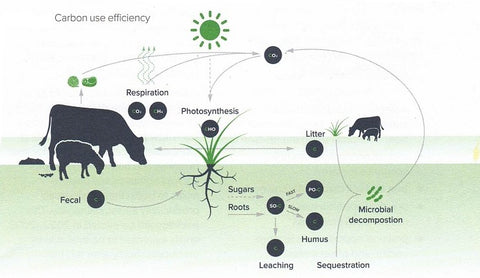Aussie Uggs business is based on a natural material – sheepskins – a by-product of the lamb meat industry. The Australian lamb meat industry is one of the few food industries around the world that is not contributing to global warming. It is a natural, sustainable, climate neutral, industry and we are proud to be associated with it. Outlined below is information from a leading Australian research scientist at Australia’s premier research institute, the Commonwealth Scientific and Industrial Research Organisation (C.S.I.R.O.),that supports these claims.
The C.S.I.R.O. is an Australian government owned scientific research organisation, with an international reputation for innovative and quality scientific research. It was established in 1916, so has been operating for more than a hundred years. In that time, it has not only provided leading edge scientific discoveries that have benefited Australian industries such as agriculture, mining and high-tech manufacturing, but also provided the world with technologies we all use every day including; fast WiFi; polymer banknotes; the CSIRO Total Wellbeing Diet; and Aerogard; just to name a few of the C.S.I.R.O’s innovations.
https://www.csiro.au/en/about/We-are-CSIRO
Recent research (2017) by Dr Bradley Ridoutt, a senior research officer at the C.S.I.R.O., shows Australia’s sheep meat industry, despite having significantly increased production over the past 30 years, is not contributing to the global increase in temperature. In fact, the trend since 2020 is going the other way, that is, the industry is helping to reduce global warming. Dr Ridoutt has calculated emissions from Australia’s sheep meat flock since 1990, the year Australian’s national carbon accounts began. It drew on annual Australian greenhouse gas emission data from 1990 to 2017 to measure the ‘’radiative forcing’’ footprint of the Australian sheep meat industry.
“Radiative forcing” is the difference between solar irradiance (sunlight) absorbed by the Earth and energy radiated back to space. “Radiative forcing” is a more accurate measure of the impact of an industry like sheep farming, which has a different array of green gas emissions, mainly methane rather than carbon dioxide (CO2), the main emission of conventional fossil fuel-based industries, and it is further complicated by the fact that the pastures livestock graze on are CO2 sequestering, that is they take CO2 out of the atmosphere. Grazing sheep are part of a natural carbon cycle as illustrated in Figure 1 below. They emit methane through burping and flatulence, but not CO2 . Methane (CH4) is much shorter-lived molecule in the atmosphere than CO2 and is destroyed through oxidation after 10 or 12 years to produce carbon dioxide and water vapour. So, what is important when measuring the contribution to global warming is not just CO2 emissions, or CO2 equivalent emissions which count methane in terms of CO2 equivalence, but the actual contribution to warming the entire system produces. Account must be taken of the total carbon efficiency of the system as illustrated in Figure 1, and as can be seen it is much more complex than simplistic measures of CO2 emissions.
Figure 1

Source: "Getting Set for Carbon Accounting" Feedback Magazine - Special Edition, Meat and Livestock Australian 2022.
Dr Ridoutt uses an analogy with a bathtub to show the differences between long-lived greenhouse gases (such as CO2 and Nitrous Oxide (N2O ) and short-lived greenhouse gases such as methane (CH4).
“With CO2 it is like a bathtub with the plug left in – you turn the tap on and the level just keeps growing and growing and growing. As more CO2 emissions are released, more is added to the accumulating ‘’stock’’ of CO2 in the atmosphere.
“With methane (CH4) it is like a bathtub but with the plug out. You have got some water going into the bath from a tap and some going down the drain".
Dr Ridoutt’s research showed that the “radiative forcing” footprint of Australia’s sheep meat sector had plateaued over the past 30 years and was predicted to reach a point of a net zero increase by 2020, a status that could be described as “climate neutral”. Figure 2 below shows past and forecast “radiative forcing”, that result from the sheep meat industry.
The explanation for this is a downward trend in methane emissions, from 371 kt in 1990 to 290 kt in 2017. Since methane has a relatively short atmospheric lifetime, of around 12 years, historical methane emissions are dissipating more quickly than being replaced by current emissions. The stabilisation of the sector’s radiative forcing footprint meant it is no longer driving atmospheric temperature increases.
“The Australian sheep meat industry has already achieved a status of stabilisation, which is consistent with the goal of stabilising global atmospheric temperature,” Dr Ridoutt said.
And what is more important, Dr Ridoutt’s calculations show that the Australian sheep meat industry will meet the 2015 Paris Agreement targets to halt global warming. In other words the Australian sheep meat industry is doing its bit to meet globally agreed climate targets and the by- products of the Australian sheep meat industry, such as the sheepskins used to make Ugg boots and sheepskin slippers are part of the solution to global warming, not part of the problem like footwear made from synthetic materials derived from fossil fuels.

Figure 2. Past and Forecast “Radiative Forcing” by the Australian Sheep Meat Industry. Historical 1990-2017 Forecast 2018- 2050.
https://publications.csiro.au/publications/publication/PIcsiro:EP202950
The abstract of Dr Ridoutt’s paper, reproduced below, explains his innovative methodology;
“The goal of limiting mean global temperature rise to 1.5 °C, described in the Paris Agreement, depends upon urgent action to stabilize radiative forcing (RF). However, the contribution of different greenhouse gases (GHGs) to future RF is often obscured by the application of climate metrics, such as the 100-year global warming potential (GWP100). RF climate footprints are an alternative way of presenting emissions information relating to GHGs and other climate forcers. These footprints include RF from current emissions as well as the fraction of historical emissions that remain in the atmosphere. The profile over time can support the management of RF toward targets informed by climate stabilization goals. In a study involving Australian sheep production for meat, it was found that the sector’s contribution to RF has plateaued in recent years at 0.64 mW.m-2, and is projected to reach the point of net zero increase in 2020, a status that could be described as “climate neutral”. Further, on present emission trajectories, the sector’s contribution to RF will decline to 0.50 mW.m-2 in 2049, which represents a contribution to climate cooling consistent with the Paris Agreement. RF climate footprints clearly articulate the diverse climate impacts of short and long-lived climate forcers, avoiding the policy ambiguity that can arise when different climate metrics and different arbitrary time horizons are chosen. This new RF framework, soon to be supported by an international (ISO) standard, has relevance in aligning food systems with the aspirations of the Paris Agreement. However, the challenge of stabilizing and managing RF downward is applicable to all sectors and organisations.”
